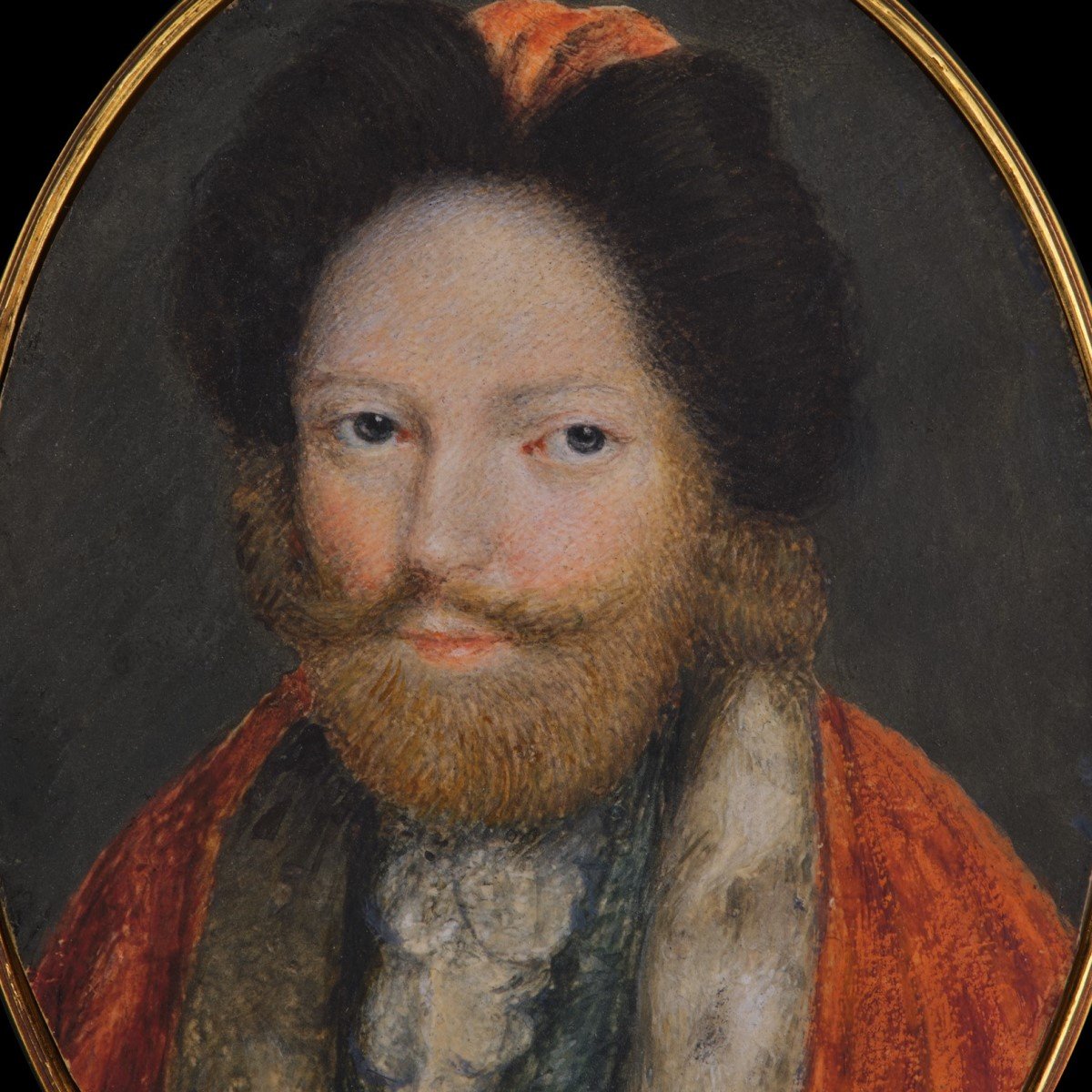JACQUES-ANTOINE ARLAUD (1668-1743)
Portrait miniature of James Brydges, 8th Baron Chandos (1642-1714), wearing Turkish dress[1], including fur-lined red pelisse (or kaftan) over blue embroidered waistcoat; circa 1687
Watercolour on vellum
Inscribed in ink verso; ‘James/ Lord Chandos/ Ambassador/ at Constantinople/ from 1680/ to 1687.’[2]
Gold locket frame, the reverse with cipher double ‘C’ under a baron’s coronet[3]
Oval, 6.5 inches high
Provenance: Likely by family descent.
SOLD
“Attired in Turkish dress, contemporary observers noted that he had even grown his facial hair to promote his suitability for the role of English Ambassador to Constantinople…”
James Chandos (1642-1714), was the son of Sir John Brydges, 2nd Baron Chandros, who improved the family wealth by marrying an heiress called Mary Pearle of Aconbury and Dewsall. When Royalist forces burned down their house at Wilton, unsurprisingly James’s father became a committed Parliamentarian. These political views continued via his son, who opposed the crown in the House of Lords. A member of the Levant (Turkey) Company, from the 1670s, James’s wife Elizabeth was also the daughter of a prominent merchant, Sir Henry Barnard.
In 1680, Chandos was appointed as English Ambassador to Constantinople by the Levant Company who made payment of his salary and covered his considerable expenses. If it had been left to King Charles II, Chandos would not have been chosen for the role, however, the election fell to the hands of the trading company and so the appointment was made. The year after, Chandos set out for Constantinople and was greeted by the previous ambassador, Sir John Finch, with ‘a genuine sigh of relief’ that he was leaving all the difficult issues with the truculent vizier Kara Mustapha Pasha to a new caretaker.
As noted by G. R. Berridge, ‘for many years afterwards the Levant Company was very much the senior partner in the British Embassy at Constantinople, and the ambassador was not allowed to forget it.’[4] As well as acting for the Levant Company and the interests of his father-in-law, Chandos could also be expected to make his own personal fortune. Although titled, Chandos was impoverished, and through the post 'raised his estate considerably by it’.[5] His need to raise funds may have been partially necessitated by James and Elizabeth’s fourteen children requiring continual financial support.
In one of the earliest miniatures by the Genevan Jacques-Antoine Arlaud, the current portrait was almost certainly painted as Chandos made his way home, travelling through France after leaving Turkey in 1687. Attired in Turkish dress, contemporary observers noted that he had even grown his facial hair to promote his suitability for the role – a quirk also seen in the portrait painted just prior to his election as ambassador, in an oil painting by an unknown artist dating to circa 1680.[6][7]
Chandos was by all accounts relaxed, sociable and hospitable, with little interest in diplomacy. Although he initially attempted to intervene by taking a strong position against the vizier’s continual pursuit of extraction of funds from the merchants, he eventually realised he was fighting a losing battle. In 1682, however, a year into his post, the advance of the Turkish army on Europe was halted and Chandos witnessed a lessening of local confidence, personally hopeful that the defeat would 'work a perfect cure on their ill lives and worse manners’.[8] In 1684, he was recalled by King Charles II, given the reason that his reports from Constantinople were not frequent or detailed enough. The real motive was likely political, with Charles looking to revenge himself on the Whigs, but whatever the reason, Chandos took his time coming home. Arriving back in England probably early in 1688, he was greeted by a rapidly changing situation – with James II forced into exile while a new king, William III, took power.
This portrait predates images such as Liotard’s self-portrait in Turkish costume, painted just prior to his visit to London in 1753 and after his extended visit to Constantinople in 1738-43. The trend for wearing such dress was termed ‘Oriental’ costume, and for Europeans only really became fully acceptable (and fashionable) after the publication of Jean-Baptiste Van Mour’s engravings in 1712.[9] Before this date, such a portrait would have been considered highly unusual. As one of only two known portraits of Chandos, it is clear that it was important for him to mark his time as Ambassador – a role which seems to have been of both personal and professional significance.
[1] Dr. Philip Mansel notes that this is the dress of ‘rich Christians in the Ottoman Empire’ (private correspondence, March 2022).
[2] In fact, although Brydges lived at Constantinople until 1687, he was recalled from the position of ambassador in 1684 having served just three years in the role.
[3] The locket frame dates to the early 18th century and was likely placed around the miniature at the time of Lord Chandos’ death in 1714.
[4] G. E. Berridge, British Heads of Mission at Constantinople 1583-1922, Leicester, 2020 (PDF article accessed May 2023).
[5] Hist. MSS. Comm., Portland Papers, ii. 242. Chandos would have been paid 8,000 dollars per annum. The Sultan was also expected to pay the ambassador a daily sum.
[6] Sir James Brydges, 8th Baron Chandos (1642-1714) Levant (Turkey) Company representative and Ambassador to Constantinople, British 17th century unknown, Oil on canvas, c.1680, Government Art Collection.
[7] 1 North, Examen, p. 466. Taken from The English Embassy at Constantinople, 1660-1762 A. C. Wood, The English Historical Review, Vol. 40, No. 160 (Oct., 1925), pp. 533-561).
[8] 5 State Papers, Foreign Archives, Levant Company, 154, p. 408.
[9] J-.B. Van Mour, Recueil de cent estampes etc etc 1707 et 1708, Paris, 1712.





